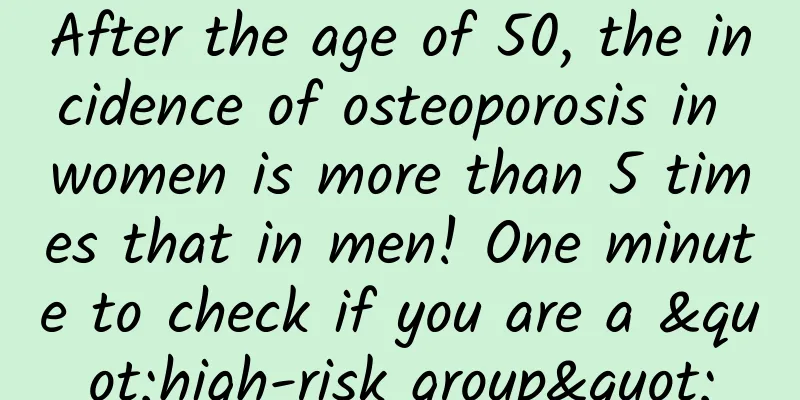After the age of 50, the incidence of osteoporosis in women is more than 5 times that in men! One minute to check if you are a "high-risk group"

|
Today (October 20) is the 27th World Osteoporosis Day . Do you really know about this "silent killer"? Osteoporosis is a metabolic bone disease caused by various reasons, characterized by a decrease in the amount of bone tissue per unit volume. Osteoporosis can occur in different genders and at any age, but is more common in the middle-aged and elderly population. The main symptoms are bone pain and easy fractures. Osteoporosis was once known as the "silent killer". It is a potential factor that causes pain, mobility problems, fractures and life-threatening conditions in the elderly. The most serious hazard is disability and incapacity caused by brittle fractures . According to the results of the first epidemiological survey on osteoporosis in China published by the National Health Commission in October 2018: Osteoporosis has become a major health problem for the middle-aged and elderly population in China, with the prevalence of osteoporosis in people over 50 years old being 19.2%. The osteoporosis problem is particularly serious in middle-aged and elderly women , with the prevalence of osteoporosis in men over 50 years old being 6.0%, while the prevalence in women is as high as 32.1%, which is more than five times that of men! The prevalence of osteoporosis in women over 65 years old is as high as 51.6%, which means that one in every two women may suffer from osteoporosis. It is worth noting that the prevalence of osteoporosis in Chinese men is not much different from that in other countries, but the prevalence in women is significantly higher than that in Europe and the United States. So why is osteoporosis more likely to occur in middle-aged and elderly women? Let us learn about it today. Why Osteoporosis Is it easier to find middle-aged or older women? 1 Growth and development differences Generally speaking, 90% of the human body's bone mass is accumulated before the age of 20, 10% is accumulated between the ages of 20 and 30, and the bone mass reaches its peak at around the age of 35. Women's skeletons and bone mass are smaller than men's, and their cross-sectional area is 25% to 30% smaller than that of men. Women's peak bone mass is often lower than that of men, and their bone calcium reserves are relatively small. After the peak bone mass period, bones will gradually degenerate, especially in women, where various physiological periods will also lead to a decrease in bone mass, such as pregnancy and breastfeeding. After menopause, bone mass drops precipitously. Copyright images in the gallery. Reprinting and using them may lead to copyright disputes. 2 Hormone levels Since estrogen has the function of promoting early osteoblast differentiation, stimulating collagen and inhibiting osteoclast activity. However, with age, women's estrogen levels gradually decrease, and the magnitude and speed of the decline are much greater than those of men, especially during perimenopause, when estrogen levels drop precipitously, causing bone destruction to exceed bone formation, resulting in a large loss of bone mass and reduced bone density. This is also one of the main reasons why osteoporosis is more common in women. Between the age of 35 and menopause, women begin to experience a slow loss of bone mass, losing about 0.3% to 0.6% of bone mass each year. Therefore, this period is considered a critical period for preventing and delaying osteoporosis. By adjusting lifestyle and dietary structure, efforts can be made to control bone loss. After entering perimenopause, women's ovarian function gradually declines, resulting in a significant decrease in estrogen secretion. This process reduces bone formation and increases bone resorption, leading to a significant reduction in bone mass. Generally speaking, within 15 to 20 years after menopause, women's bone mass may decrease to 33% to 50% of their peak bone mass, and the rate of bone loss begins to slow down after the age of 70. The bone mass that women ultimately lose in their lifetime is about 50% of their peak bone mass, while the figure for men is relatively low, about 30%. 3 Other important causes Due to cultural traditions, Asian women are relatively quiet, lack physical activity, lack effective sunlight, and prefer a vegetarian diet, which is also one of the causes of osteoporosis. In addition, some women diet excessively to achieve aesthetic goals, leading to nutritional imbalance; their preference for fair skin leads to excessive sun protection, leading to 25-hydroxyvitamin D deficiency. These are important reasons why modern women suffer from osteoporosis, with an incidence rate significantly higher than in Europe and the United States. If these occur, it means you have osteoporosis If you have sudden back pain, multiple bone pains and have ruled out other osteoarthritis, or gradually develop a hunchback, you should pay attention to it. You may have osteoporosis. If you suspect you have osteoporosis, you can take a 1-minute questionnaire to see if you are in a high-risk group: International Osteoporosis Foundation (IOF) Osteoporosis Risk One minute test If you answer "yes" to any of the following questions, it is considered positive , indicating the risk of osteoporosis. A bone density test or FRAX® risk assessment is recommended. Uncontrollable factors: 1. Have your parents ever been diagnosed with osteoporosis or suffered a fracture after a minor fall? 2. Does one of the parents have a hunchback? 3.Actual age is over 40? 4. Did you suffer a fracture due to a minor fall as an adult? 5. Do you fall often (more than once in the past year), or are you worried about falling because of your weak body? 6. Has your height decreased by more than 3 cm since the age of 40? 7. Are you underweight (BMI less than 19)? 8. Have you ever taken steroid hormones (such as cortisone, prednisone) for more than 3 months? 9. Do you suffer from rheumatoid arthritis? 10. Have you been diagnosed with hyperthyroidism or hyperparathyroidism, type 1 diabetes, gastrointestinal disease such as Crohn's disease or celiac disease, or malnutrition? The lady replied: 11. Did you stop menstruating at age 45 or earlier? 12. Have you ever stopped having menstrual periods for more than 12 months, other than due to pregnancy, menopause, or hysterectomy? 13. Did you have your ovaries removed before age 50 and not take estrogen/progesterone supplements? The man answered: 14. Have you ever experienced impotence, loss of libido, or other symptoms related to low androgen levels? Lifestyle (controllable factors) 15. Do you often drink large amounts of alcohol (more than two units of ethanol per day, equivalent to 1 jin of beer, 3 liang of wine, or 1 liang of spirits)? 16. Are you a current smoker or have you ever smoked? 17. Do you exercise for less than 30 minutes a day (including doing housework, walking, running, etc.)? 18. Can’t eat dairy products and not taking calcium tablets? 19. Do you spend less than 10 minutes outdoors every day and do not take vitamin D? Among the hazards of osteoporosis to the human body, the most common is fracture: First, spontaneous fractures . The most common type is thoracic and lumbar vertebral compression fractures. The stress on the thoracic and lumbar vertebrae is relatively concentrated. When the bone mass decreases, a slight twist or bending movement may cause spontaneous compression fractures and severe pain. Second, when falling or spraining occurs, the porous bones are more prone to fractures , which are common in the limbs, such as femoral neck fractures, intertrochanteric fractures, and distal radius fractures in the elderly. They can also occur in the spine or ribs, and are also prone to cause nerve damage and complications of other organs. How to prevent osteoporosis? The survey results show that the diagnosis and treatment rate of osteoporosis in China is still insufficient . Among the people over 50 years old in China, only 3.7% have received bone density testing. Even if the patient has osteoporotic fractures (vertebral fractures and hip fractures), the diagnosis rate of osteoporosis treatment is only about 2/3. In addition, residents generally lack knowledge about osteoporosis , and the bone density testing rate needs to be improved urgently. The osteoporosis-related knowledge awareness rate among people over 20 years old is only 11.7%. Among osteoporosis patients, the proportion of people who know that they have the disease is also low. The awareness rate of osteoporosis patients aged 40 to 49 is 0.9%, and the awareness rate of patients over 50 is only 7.0%. Among people over 50 years old, the proportion of people who have undergone bone density testing is 3.7%. Copyright images in the gallery. Reprinting and using them may lead to copyright disputes. On the other hand, due to the low bone mass and early stages of osteoporosis which usually have no obvious clinical manifestations, the public lacks awareness of the importance of osteoporosis prevention. In addition, the osteoporosis prevention and treatment capabilities of primary medical and health institutions are insufficient. The bone density detection rate of Chinese residents is low, and most residents do not take timely prevention and control measures in the early stages of bone mass decline. They only discover that they are ill after experiencing pain, spinal deformities, and fractures, thus missing the favorable opportunity for osteoporosis prevention and treatment. Therefore, the first thing to do to prevent osteoporosis is to know and understand it. Next, you can also prevent and treat osteoporosis from the following 5 aspects: 1 Exercise Adhere to appropriate outdoor exercise and control your weight to effectively improve bone density. Weight-bearing exercise that strengthens bones includes walking, jogging, Tai Chi, yoga, dancing, and table tennis; exercise that strengthens muscle function includes weight training and other resistance exercises. It is recommended to choose the appropriate exercise intensity according to your actual situation and exercise regularly. 2 Eat a healthy diet It is recommended to take a balanced diet rich in calcium, low in salt and with an appropriate amount of protein. Increasing the intake of calcium-rich foods (such as dairy products and soy products) and taking appropriate calcium supplements can effectively enhance lower limb muscle strength and bone density, reduce pain, and prevent the occurrence of osteoporosis. 3 Sufficient sunshine Sunbathing helps promote the synthesis of vitamin D in the body and is beneficial for calcium absorption. When you are sunbathing, be careful: do not apply sunscreen or wear sun-protective clothing! Expose your skin directly to the sun and receive enough ultraviolet rays, about 10 minutes a day is enough, but be careful to prevent your skin from being burned by strong sunlight. 4 Regular inspection In addition to learning the above knowledge points about osteoporosis prevention and treatment, it is also very important to conduct regular bone density checks, which helps to detect signs of osteoporosis early and take corresponding prevention and treatment measures. Copyright images in the gallery. Reprinting and using them may lead to copyright disputes. In addition, many people have some misunderstandings about osteoporosis, such as the following 5 common ones: ① Drinking bone soup can prevent and treat osteoporosis❌ ② Calcium supplementation is the treatment of osteoporosis❌ ③ Osteoporosis has nothing to do with young people ❌ ④ Discover osteoporosis by self-feeling ❌ ⑤ It’s too late to treat osteoporosis in the elderly ❌ References [1]. National Bureau of Statistics of the People's Republic of China. China Statistical Yearbook[M]. Beijing: China Statistics Press, 2022. [2]. Chinese Center for Disease Control and Prevention, Chinese Medical Association Osteoporosis and Bone Mineral Disease Branch. Epidemiological Survey Report on Osteoporosis in China (2018)[M]. Beijing: People's Medical Publishing House, 2021. Planning and production Author: Deng Ting, attending physician of orthopedics department of Changsha Third Hospital Reviewer: Ji Gang, deputy chief physician of orthopedics, the First Hospital of Hebei Medical University Planning丨Wang Mengru Editor: Wang Mengru Proofread by Xu Lailinlin The cover image and the images in this article are from the copyright library Reprinting may lead to copyright disputes |
>>: Will the little ducks who were born in the wrong place really be excluded?
Recommend
Why didn't archaea evolve into organisms more advanced than humans?
In most people's eyes, bacteria are bad thing...
Yan Jie "Stretching Light Yoga" 14-day fast-acting metabolic slimming yoga tutorial video
Training course content: CCTV's specially inv...
Activity promotion review: To do a good live broadcast event, you need to pay attention to these 3 points
How to do a live broadcast with over 2 million ex...
The stomach is most afraid of these "several things". One more thing will bring you closer to gastric cancer! Doctors: Many people are diagnosed at the late stage
Expert of this article: Hu Zhongdong, chief physi...
What happened to this iOS?
My phone has gone black and turned black three ti...
Introduction to home decoration space design
Starting from the basics, we will understand the ...
Does looking up your head to play with your phone really help prevent cervical spondylosis? Experts urgently remind
Many young people frequently experience cervical ...
On the Lantern Festival, go to the big ship to look for "rabbit"!
The Lantern Festival is coming "Rabbit"...
Why can’t I fall asleep even though I’m so tired?
Although many people suffer from insomnia, few pe...
FAW-Volkswagen's volume and price have collapsed. It's time for Chinese companies to rescue it.
FAW-Volkswagen, once the king, sold 124,000 vehic...
How to build a p2p product operation strategy from 0 to 1?
Having been in the Internet finance industry for ...
ASO Optimization: How to optimize the Android App Market?
How to optimize gaming apps and how to promote th...
Will artificial intelligence replace humans? Don't worry, you're overthinking it
TechCrunch, a US technology website, wrote an arti...
Would you like to know the 10 tips for Weibo operation and promotion?
Would you like to know about the ten tips for Wei...
Love life and prevent suicide, what can we do?
Follow "Body Code Decoding Bureau" (pub...









